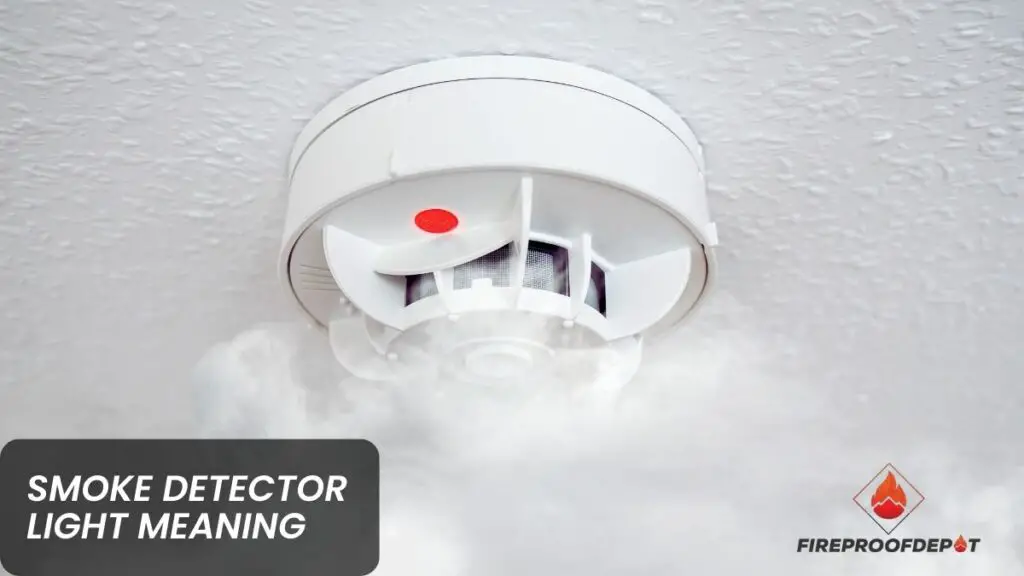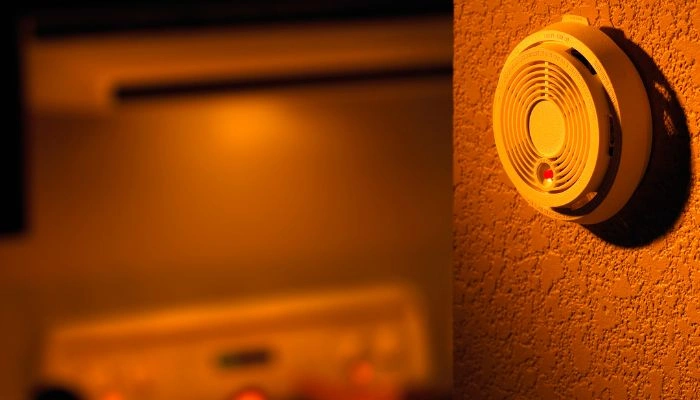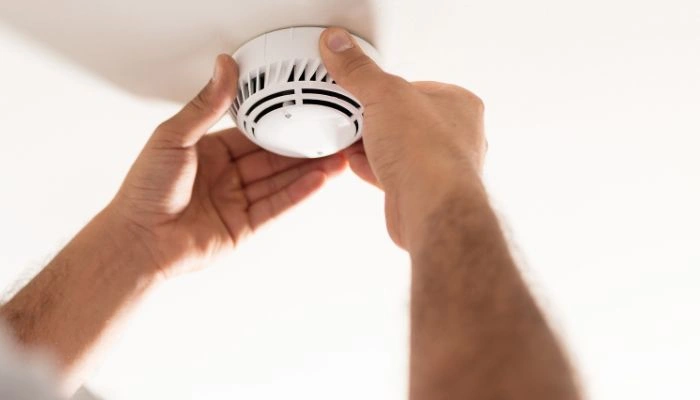Smoke detectors are crucial devices that play a vital role in safeguarding our homes and workplaces against the devastating threat of fires. While their piercing alarms are well-known, the lights found on smoke detectors often go unnoticed or misunderstood.
The meanings of different lights in a smoke detector are: Power/status light (green for normal, amber for warning), an alarm indicator light (red for active alarm), and an error/fault light (flashing red for malfunction).
Here, we will unravel the mystery behind the smoke detector light meanings, shedding light on the different types of lights and their implications. Join us as we crack the code of smoke detector lights, empowering you with the knowledge to understand and respond appropriately to these crucial safety signals.

Different Types Of Light In Smoke Detectors
There are different sets of lights in a smoke detectors based on different brands and different models. But mainly you will find three types of lights in a smoke detector. They are Status Power Lights, Warning Lights, and Error or Fault Lights.
Every light has a unique meaning that sometimes expresses some serious message to the house owner. That’s why you must know the meanings of this light. Here are some examples of lights with their meanings.
Power/Status Light
- Color: Green or steady light.
- Meaning: This light indicates that the smoke detector is functioning properly and has power.
- Possible Causes: A steady green light signifies that the smoke detector is receiving power and is in a normal operating state. It indicates that the detector is connected to a power source and functioning correctly.
If the power light is not lit or is a different color, it may indicate a problem with the power supply or the smoke detector itself. Potential causes can include a power outage, disconnected power source, or a faulty detector.
Warning Light
- Color: Amber or yellow light.
- Meaning: This light serves as a warning or caution signal, indicating a potential issue with the smoke detector.
- Possible Causes: An amber or yellow light can indicate various issues, such as a low battery or a malfunctioning detector. The common causes for the warning light include a depleted or weak battery, the need for battery replacement, or a fault in the detector’s circuitry.
It is important to address the warning light promptly to ensure the smoke detector’s optimal performance.
Error or Fault Light
- Color: Red light or flashing light.
- Meaning: This light indicates a fault or error condition in the smoke detector.
- Possible Causes: The red light or flashing light signifies a malfunction or error condition in the smoke detector. Possible causes can include a sensor failure, internal circuitry issue, or a problem with the smoke detection mechanism.
- Solutions Of These Lights
- Check the detector’s user manual or manufacturer’s instructions for specific troubleshooting guidance.
- Ensure the smoke detector is clean and free from any dust or debris that may interfere with its operation.
- Replace the battery if applicable or try resetting the smoke detector by removing and reinserting the battery.
- If the error light persists or recurs, it’s advisable to contact the manufacturer or a professional for further assistance or consider replacing the smoke detector.
The exact light indications and solutions can vary between different smoke detector models and manufacturers. It is essential to refer to the user manual or manufacturer’s instructions specific to your smoke detector for accurate information and troubleshooting steps.
Reasons Why Smoke Alarms Chirp With Solution
Smoke alarms chirp or emit a repetitive beep to indicate a problem or issue that requires attention. Here are some common reasons why smoke alarms chirp:

Low Battery
One of the most common reasons for a smoke alarm to chirp is a low battery. When the battery power drops below a certain level, the alarm produces a chirping sound to alert you to replace the battery.
Regularly replacing the battery is crucial for ensuring the smoke alarm’s proper functioning.
Solution: Replace the battery with a fresh, high-quality battery specifically recommended by the manufacturer. Follow the instructions provided in the user manual for battery replacement.
Faulty or Expired Battery
Even if the battery is not low, it may be faulty or expired, which can cause the smoke alarm to chirp intermittently. Over time, batteries lose their effectiveness, and using expired or weak batteries can lead to false alarms or unreliable operation.
Solution: Replace the battery with a new one, ensuring it has not expired and is compatible with the smoke alarm model.
Dust or Debris
Accumulated dust, dirt, or debris in the smoke alarm can interfere with its sensors and cause false alarms or chirping sounds. These particles can disrupt the proper functioning of the smoke alarm and trigger false alerts.
Solution: Regularly clean the smoke alarm by gently vacuuming or using compressed air to remove any dust or debris. Follow the manufacturer’s instructions for cleaning to avoid damaging the device.
Malfunctioning Smoke Alarm
In some cases, the smoke alarm itself may be faulty or experiencing a malfunction. This can lead to false alarms, frequent chirping, or other irregular behavior.
Solution: If the chirping persists even after replacing the battery and cleaning the smoke alarm, it may be a sign of a malfunction. Contact the manufacturer or a qualified technician to inspect the smoke alarm and, if necessary, replace it with a new one.
Power Interruptions
Smoke alarms that are hardwired into the electrical system of a building may chirp briefly after a power outage or when power is restored. This is a normal response as the smoke alarm resets itself.
Solution: Allow the smoke alarm to reset on its own, and the chirping should stop once power is fully restored.
Additional Functionality & Alerts Of Smoke Detector
Smoke detectors have evolved to include additional functionality and alerts beyond the basic detection of smoke. Here are some common additional features and alerts found in modern smoke detectors:
Carbon Monoxide (CO) Detection
Many smoke detectors now incorporate carbon monoxide sensors alongside smoke sensors. Carbon monoxide is a colorless, odorless gas that is harmful when inhaled.
Smoke detectors with CO detection capabilities can provide early warnings for both smoke and carbon monoxide, ensuring comprehensive protection.
Dual-Sensor Technology
Some smoke detectors utilize dual-sensor technology, combining both ionization and photoelectric sensors. Ionization sensors are more sensitive to fast-flaming fires, while photoelectric sensors are better at detecting slow, smoldering fires.
Dual-sensor smoke detectors provide enhanced detection and can respond more effectively to different types of fires.
Voice Alerts
Instead of just sounding an alarm, some smoke detectors include voice alerts. These voice notifications provide spoken warnings, indicating the presence of smoke, fire, or carbon monoxide.
Voice alerts can be particularly useful for individuals who may have difficulty hearing traditional alarm sounds.
Wireless Interconnectivity
Smoke detectors with wireless interconnectivity can communicate with each other within a network. When one smoke detector detects smoke or fire, it triggers all the interconnected units to sound their alarms simultaneously.

This feature ensures that occupants are alerted to the danger from various locations within a home or building.
Smart Connectivity
Smart smoke detectors can connect to a home’s Wi-Fi network, enabling remote monitoring and control via a smartphone app.
These detectors can send alerts to your phone in the event of smoke or CO detection, allowing you to take immediate action even when you’re away from home.
Some smart detectors can also integrate with other smart home devices, such as security systems or voice assistants, for enhanced functionality.
Low Battery Alerts
In addition to the audible chirping sound, smoke detectors often have low battery alerts that indicate when the battery needs replacement. These alerts can be in the form of a flashing light or a specific sound pattern, reminding you to replace the battery promptly.
End-of-Life Alerts
Smoke detectors have a limited lifespan, typically around 10 years. After this period, the sensors and components may become less reliable.
Modern smoke detectors feature end-of-life alerts that indicate when the device has reached the end of its usable life and needs replacement.
Conclusion
Understanding the meanings of the lights on a smoke detector is essential for maintaining a safe environment.
From the power/status light indicating normal operation or a warning, to the alarm indicator light signaling an active alarm, and the error/fault light indicating a malfunction, these lights provide crucial information.
By familiarizing ourselves with these signals and their possible causes, such as low batteries or sensor failures, we can promptly address any issues and ensure the smoke detector’s optimal performance.
